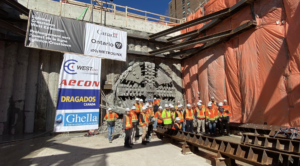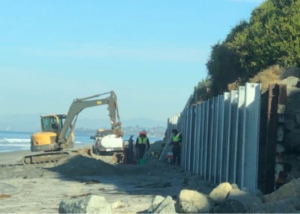MxV Rail Deck Anchor Spacing for Timber Ties on Open Deck Steel Bridges
Written by MxV Rail, Corporate Communications
PUEBLO, Colo. –– RAILWAY TRACK AND STRUCTURES, OCTOBER 2023 ISSUE –– MxV RAIL
Authors: Christopher Johnson, PE – Scientist
Duane Otter, Ph.D., PE – Scientist
Dante DeVencenty – Engineer
MxV Rail, Pueblo, CO
Since 1997, MxV Rail has been investigating new designs and materials that have the potential to improve safety and efficiency and reduce the maintenance required for open deck bridges. Due to the lack of quantitative data on the lateral resistance provided by ties and deck anchorage fasteners on open-deck railroad bridges, the current guidelines or requirements for deck tie fastener spacing are based on limited data and historical experience. At the request of and with guidance from MxV Rail, researchers at Virginia Tech conducted experimental testing on five tie materials, three hook bolt styles, and multiple vertical loading conditions to quantify the lateral resistance provided by tie friction, hook bolt fasteners, and tie daps for each tie and hook bolt material combination.



Table 1 (top): Minimal Lateral Resistance from Hook Bolts plus Friction
Image 1a. (middle) and Image 1b. (bottom): Hook bolt (middle) and dapped tie specimens (bottom)
MxV Rail investigators then used the lateral resistance values from this experimental testing to evaluate the current American Railway Engineering and Maintenance-of-Way Association (AREMA) Manual of Railway Engineering (MRE) Chapter 15 recommendations for deck tie fasteners on tangent and curved track. These recommendations were found to be adequate for most load cases examined. Hook bolt and tie spacing, car weight, and car type effects all have a significant effect on lateral resistance; however, the degree of curve did not have a significant effect on the lateral resistance.
Background
Ties on open deck steel bridges bear directly on the steel superstructure. Ties are typically fastened to the superstructure using hook bolts with a hook, a sprung shoe, or a spring clip at the bottom of the bolt. These bolts provide movement resistance primarily in the lateral direction and also resist uplift. Standards for fastener spacing vary between railroads. Some railroads also used dapped ties, where the bottom of the tie is notched over the top flange. The dap provides a physical restraint to lateral movement, but it can be costly to fabricate and can initiate horizontal splits in the tie. Many steel spans also have rivet heads or a portion of the girder web protruding. This protrusion provides physical interlocking and increased lateral resistance. Smooth top spans were studied as the worst-case scenario. Figure 1 provides examples of typical hook bolts and dapped ties.
Experimental Testing to Quantify Lateral Resistance
MxV Rail worked with Virginia Tech to perform experimental testing that would quantify the lateral resistance of various open-deck bridge ties and fasteners. For this testing, various railroads contributed a combination of new and used bridge deck ties, and a supplier provided components for different fastening systems. The test setup simulated the loads and movement of a railroad tie on the surface of a smooth steel beam flange.1, 2
The resistance values provided in this article are the average value minus two standard deviations. The lowest values of friction and hook bolt lateral resistance from the experimental tests were used for further analysis.
Dapped Tie Tests
Dapped ties were tested to determine the peak contribution of the daps as the edge of the dap was placed in bearing. The tests indicated that they provided more than enough lateral resistance as compared to the design lateral forces.
Friction Tests
To establish the relationship between normal force and frictional coefficient, various tie species were tested at five different vertical loads (5, 15, 25, 35, and 45 kips). The various levels of vertical force were then used to calculate coefficients of friction. At 0.195, the friction level for freshly treated ties was the lowest for mean minus two standard deviations. Other ties had values above 0.3. A value of 0.2 was chosen for fastener spacing analysis.
Fastener Tests
The lateral resistance provided by hook bolts varied based on the type of hook bolt, the vertical load on the tie, and the lateral displacement. Table 1 shows the lowest values of lateral resistance (hook bolt plus friction) for all hook bolt types for three vertical loads.
Analysis of Total Lateral Resistance
Due to the spacing of ties, anchors, and axles, along with deck construction, the lateral force resulting from a wheel is not resisted by a single tie—the load is carried by multiple anchored ties.3
Although hook bolts are typically applied to both sides of the track, only the hook bolts on one side were considered to resist lateral loads, as illustrated in Figure 2. Friction was assumed to act on both sides under load.
Lateral Loading
The total lateral loading was assumed to come from three sources defined by AREMA MRE Chapter 15. First, in Section 15.1.3.9, Lateral Forces From Equipment are defined as a single load equal to 25 percent of the live load. Second, Centrifugal Force was calculated based on the assumed speed and superelevation. Finally, Wind Force on the train was calculated per Section 15.1.3.7.4 Both the wind force and centrifugal force were limited to a total tip-over force, which is the force required to unload the inner wheel of the rail vehicle.
Figure 3 depicts equipment variables. All vehicle combinations were evaluated with 5-, 25-, and 45-kip wheel loads. Span and track variables included tie and hook bolt spacing and various amounts of curvature and superelevation. A missing hook bolt case examined the realities of hook bolts breaking, loosening, or dropping.

Figure 2. Components of Bridge Deck Lateral Forces and Resistance using Ties Without Daps

Figure 3. Car Types and Axle Configurations Considered

Table 2. Highlights of Analysis Results – Percentage of Cases Meeting Minimum Factor of Safety, Ties Without Daps
Results
The MxV Rail team evaluated lateral loads and resistances for all reasonable equipment and speed combinations, as well as ties without daps. The total lateral load was distributed to the deck components (ties and hook bolts) based on the type of car and truck axle spacing. The calculated resistance was compared to the calculated load, and a factor of safety (FOS) was determined for each case. The minimum FOS criteria were defined as 1.0 in cases with wind and 1.25 in cases without wind. Other designers may choose to use different FOS.
The combinations were then compared against the two hook bolt spacing criteria shown in Table 2. Currently, AREMA recommends hook bolt spacing every four ties on tangent track not to exceed 4 feet 8 inches and having a reduced spacing on curves.
Conclusions and Recommendations
Of the variables considered, wind load and wheel load had larger effects than other variables. The type of car also had a large effect with the most significant challenges stemming from long lightweight cars, such as autoracks with high wind loads and empty cars where light wheel loads reduce the amount of frictional resistance available. Although lateral loads changed, the degree of curvature did not have a large effect on hook bolt spacing, thus consistent hook bolt spacing (as with spacing criteria A) may be appropriate for all curves. As expected, tie and hook bolt spacing also had a large effect, and therefore, a missing hook bolt also had a large effect. Maintenance and inspection practices should be considered when using undapped ties with wider tie and hook bolt spacings on smooth-top steel spans.
The lateral resistance design of open-deck bridge tie fastenings is now possible with quantified data. Additional research into the following would also be recommended: 1) other tie materials, treatment types, riveted-top girders, and changes in friction over time; 2) acceptable safety factors weighed against risk; and 3) a better understanding of lateral load distribution.
Test data for dapped ties indicate that these ties provide a significant amount of lateral resistance in excess of what is required. Based on the analysis presented, the current AREMA guidelines accommodate most load cases without the use of dapped ties, even on smooth-top steel spans.
Acknowledgements
The authors acknowledge the support and guidance provided by the Association of American Railroads (AAR) Bridge Technical Advisory Group; CSX Transportation, Norfolk Southern Railway, and Union Pacific Railroad for tie donations; Lewis Bolt & Nut for hook bolt donations; and Dr. Matt Hebdon and his students at Virginia Tech for their work on the experimental study.
References
- Gergel, J., Vasudevan, V., and Hebdon, M. “Railroad Tie Lateral Resistance on Open-Deck Plate Girder Bridges,” Railway Technologies Laboratory, 2019.
- Gergel, J., “Railroad Tie Lateral Resistance on Open-Deck Plate Girder Bridges,” Master’s Thesis, Virginia Polytechnic Institute, Blacksburg, Virginia, 2019.
- Igwemezie, J., “Understanding Stresses in Rails,” Interface J., 2007.
- AREMA, “Steel Structures,” in AREMA Manual for Railway Engineering, Lanham, Maryland: American Railway Engineering and Maintenance-of-Way Association, 2021
- Johnson, C., Hebdon, M., and Otter, D., “Lateral Resistance of Timber Bridge Ties and Fasteners on Open Deck Steel Bridges,” Proceedings, AREMA Annual Conference, Denver, Colorado, August 2022.
- Johnson, C., Otter, D., and DeVencenty, D., “Fastener Spacing for Timber Ties on Open Deck Steel Bridge,” Technology Digest TD22-028, MxV Rail/AAR, Pueblo, Colorado, 2022.





